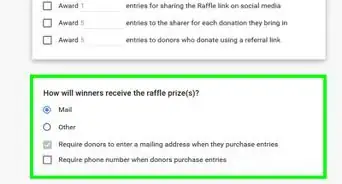wikiHow is a “wiki,” similar to Wikipedia, which means that many of our articles are co-written by multiple authors. To create this article, 24 people, some anonymous, worked to edit and improve it over time.
wikiHow marks an article as reader-approved once it receives enough positive feedback. In this case, 90% of readers who voted found the article helpful, earning it our reader-approved status.
This article has been viewed 98,426 times.
Learn more...
It is entirely possible to run a very successful crowdfunding campaign without being absurdly well-connected or quitting your day job. The key to successful commercial and community crowdfunding is preparation and planning.
Steps
Figuring Out Your How and Why
-
1Be clear about your goals. Before you start your campaign, know with certainty how you will ask for money and why you need it. As crowdfunding consultant Sydney Malawer put it, “Do you have a legitimate ask besides 'we want money'?” People want to feel that they are a part of something big and important. They want to know that their money will play a significant role in accomplishing that goal. People crowdfund for all sorts of reasons: new business ventures, projects or causes they care about (e.g., a family member, friend or pet who is sick).
-
2Do research and outline your goals. To justify and support your goals, you'll need to be clear about what the money will do. For personal causes, outline clearly how the money will be used and what impact it will have.Advertisement
-
3Present your goals. For commercial ventures, use graphs where useful. Write out an estimated budget for your campaign, based on any quotes you've received from manufacturers, insurers, lawyers, suppliers and distributors. For personal causes, describe what the money is for and how it will be used. E.g., $1000 will pay for Sharon's mortgage as she undergoes four weeks of chemotherapy. If this sounds like a lot of work, it doesn't have to be. Just be transparent about what you are trying to achieve.
-
4Research crowdfunding itself. Both Kickstarter and Indiegogo provide helpful tips on their websites. Mycause.com.au, which specialises in cause-related crowdfunding, offers their fundraisers 24/7 email and phone support. Mike del Ponte wrote a great post on “Hacking Kickstarter,” offering a list of factors to consider that contribute to campaign success, and the Unreasonable Institute shared some good lessons from their failed campaign.
-
5Find videos or high-quality photos. Images can make or break a campaign. If you are crowdfunding for a commercial project, consider getting a professional videographer who is willing to work pro-bono, or make a video yourself. Focus on telling a compelling story. Keep it under three minutes in length. For personal causes, find heartwarming and emotional photographs, and upload them to your page. The more visuals you have, the better.
Designing Your Campaign
-
1Decide which platform to use. There are hundreds available. Kickstarter and Indiegogo are the two best options for commercial projects. Mycause.com.au generates more than $12 million a year for personal causes.
- Kickstarter is quite popular but rather picky about the projects they allow. (They're looking strictly for "creative" ideas.) It can actually be difficult to make it onto their homepage because of high traffic.
- The smaller Indiegogo may be able to feature you more prominently on their homepage, newsletter, and social media outlets.
- Mycause.com.au is the premier cause-funding site in Australia, raising more than $12 million a year for personal and charity causes. Mycause will allow you to fundraise for overseas residents or charities, as long as you are clear on how you will get the money to them. You can forward money to a charity through PayPal.
-
2Design the layout of your campaign. Have your story outlined (who, what, when, where, why, how) and your video and images in place. Make your explanation clear, simple and to-the-point.
-
3Offer rewards. Particularly in the case of commercial ventures (where people don't often give out of kindness), rewarding contributors with prizes can be an effective motivating tool. If you can cause potential donors to think, “That looks awesome. I want that,” you could then reward them with a taste of the product you produce. For example, "$25 will get you a 250ml bottle of wine. $5000 will get you a weekend of health and wellness at a Napa winery."
- Be sure to factor shipping into the cost of the rewards. Your cost will include the price of the goods, plus shipping and a crowdfunding premium (a percentage the platform will take in payment for their services).
-
4Make sure you can comply with the estimated delivery date. 70% of campaigns don't deliver on time. Select a date that gives you plenty of time to meet your commitments. New projects often take longer than anticipated.
Building the Movement
-
1Make sure you have a core team of people promoting the campaign for you. Think of crowdfunding as the layers of an onion. Your first layer is family and friends. If they won't donate to you, who will? Your second layer is coworkers (past and present), teammates, business associates, casual acquaintances. Your third layer is the press and general public.
-
2Reach out to organizations and workplaces. Some organizations can provide wide networks of potential donors. Make a list of local organizations related to your cause or field. Ask them if they'd be willing to publicize your campaign through their social media.
-
3Use the media. If you are doing the campaign on your own, you should draft a standard press release as a template. Personal interviews, however, are more likely to get you coverage. If you use a platform such as mycause.com.au, their publicity team will send your story to the press free of charge. They will work to generate publicity on your behalf.
Launching the Campaign
-
1Know your goal. If it's a commercial venture, you should aim to raise 25% of your funding within 24 hours. If you succeed at that, Indiegogo or Kickstarter might feature you on their homepages. If it's for an individual or a cause, mycause.com.au recommends reaching out to your first two layers of "the onion" (friends, family, coworkers, teammates) in the first 14 days and then going to the general public through the press after that.
-
2Try all forms of communication: email, social media (Twitter, Facebook, Instagram, Pinterest), blogs, media, opinion pieces, personalised letters. Remind your network to spread the message as well. Platforms such as mycause.com.au have integrated Facebook, Twitter and Gmail into their platform to make sending communications easy and effective. For systems that aren't fully integrated, you can try other tactics:
- In Gmail click on Contacts → More → Export (All Contacts, CSV). Then you can import those contacts into your preferred email service provider (e.g., MailChimp).
- Copy and paste the URL to your page, and give it a "New" status on Facebook. Tag supporters who will share the status.
- Focus on key influences on social media. After your general status post, reach out directly to key influences, posting specifically on their social media pages.
- Create a personal pitch. Hold an intimate event, make personal phone calls, and send individual emails to influential people who might respond to your pitch.
-
3Allow time. Plan on sending updates to your backers and networks throughout the campaign, and also after it has ceased. Don't bombard people with messages, however. They might be tempted to mark them as spam.
Community Q&A
-
QuestionHow can I find someone to help me start crowd funding?
 Community AnswerIf you're crowdfunding for yourself, then just go to one of the internet sites and follow the instructions to set up your request. If you are crowdfunding for a charity, discuss your plans with other volunteers at the charity.
Community AnswerIf you're crowdfunding for yourself, then just go to one of the internet sites and follow the instructions to set up your request. If you are crowdfunding for a charity, discuss your plans with other volunteers at the charity.













































































